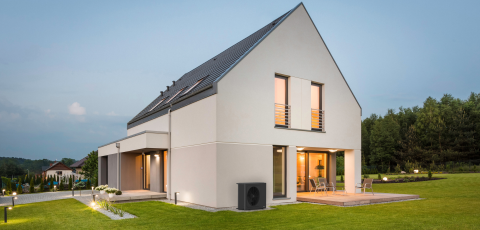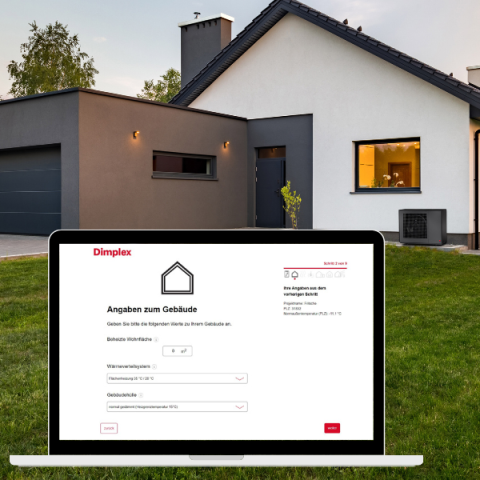
Heat Pumps in New Buildings
Heat pumps are very popular in new buildings and have been tried and tested many times. In new buildings, more and more builders are relying on heat pumps that are becoming increasingly quiet and efficient when choosing the right heating system. Well over half of all new buildings are equipped with heat pumps. This is not just because a heat pump is one of the most environmentally friendly and efficient heating solutions for a new house. In a new building, the size of the heat pump is designed so that it is the only heat generator for heating the building (monovalent design) and no other heat generators are required. Heat pumps ensure maximum living comfort and are more than just “heating”. They can do more than any fossil heating system. Heat pumps not only heat your home, they heat your hot water and cool your building in the summer. This means you have a pleasant indoor climate all year round. Due to climate change, our summers are getting warmer. The topic of cooling is therefore playing an increasingly important role in new buildings for reasons of comfort. You can also heat your pool with a heat pump.
Ihre Vorteile im Überblick
- Energy-efficient heating: one kilowatt hour of electricity generates four to six kilowatt hours of heat, depending on the annual performance factor (JAZ).
- Active contribution to climate protection: Heat pumps heat with environmental heat from the air, water or earth They save CO2 and can be operated in a CO2-neutral manner in combination with photovoltaics. In addition, electricity is becoming ever greener.
- All-rounders: Heat pumps can not only heat, but also cool and provide hot water in summer
- no supply and availability problems: independence from oil and gas for building heating and, in combination with a photovoltaic system, increasing the proportion of self-consumption
- Heat pumps are becoming increasingly quieter: due to technical developments and better components
- Space-saving: Heat pumps do not take up much space in the house or garden and there is no need to store fuel in the basement.
- Perfect combination: Most new buildings are equipped with underfloor heating, which is the perfect prerequisite for a combination with a heat pump.
- Flexible: Heat pumps can be combined with other heat generators, such as fireplaces, solar or pellets.
- Future-proof: Heat pumps are the heating technology of the future, politically wanted and promoted and ideal in combination with a ventilation system with heat recovery
- Cheap operation: calculable operating costs and no CO2 tax on fossil fuels
- Hygienic: By combining it with a ventilation system, there is always fresh air, no mold formation and the avoidance of allergies and the heat recovery means there is no heat loss as with manual ventilation.
Combine Heat Pump with Photovoltaics
A heat pump draws a large portion of free environmental energy from nature. However, it requires electrical power to operate. If the electricity used is obtained from renewable energies such as wind, sun or water, the operation of the heat pump is practically CO 2 -neutral. The combination with electricity from the in-house PV system is ideal, as this not only reduces CO 2 but also reduces costs. To support this combination, the Dimplex heat pump can be connected to the PV system for control purposes and the income from the photovoltaic system can be efficiently used with the heat pump for heating, hot water preparation or, particularly ideally, for cooling in the summer.
The smaller proportion of energy used to operate the heat pump is electrical power. In combination with an electric solar system, you can not only generate green heat particularly efficiently, you also heat almost free of charge. Operation becomes particularly sustainable if the installed electrical solar system is connected to your heat pump system. A solar electric system can cover most of your electricity needs for your heat pump. Photovoltaic systems can cover a large part of the electricity requirements for a heat pump. This saves energy and at the same time protects the environment - heating is almost CO 2 -neutral. This also makes the operation less dependent on the electricity provider. In any case, with this solution you are independent of gas and oil.
Smart Grid Ready Function for Heat Pumps
The PV system produces a lot of electricity, especially on sunny days, especially at midday. But this is usually the time when you don't need much heat. Then it is an advantage if you operate a heat pump with the electricity you produce yourself and it has an SG-Ready function. In this case, the heat pump can produce warm water whenever electricity is available and store the energy for later consumption.
Install a Heat Pump
The effort involved in installing a heat pump is manageable. In compact systems, most of the components are already in the heat pump. This saves additional space and time during installation. With split devices, only a small opening is required, which can be placed quickly and easily. With a buffer tank you can ensure that the heat generated is stored and distributed to the heat distribution system as needed. This allows the system to work even more efficiently. Operation becomes even more efficient if you connect the hot water tank to the heat pump at the same time. In contrast to other heat generators, there are no unpleasant odors caused by heating oil, the space required by an oil tank and heavy contamination and dust caused by pellets, but also their space requirements. The heat pump is the only heating system that air-conditions your building: heating, hot water and cooling in one device.


